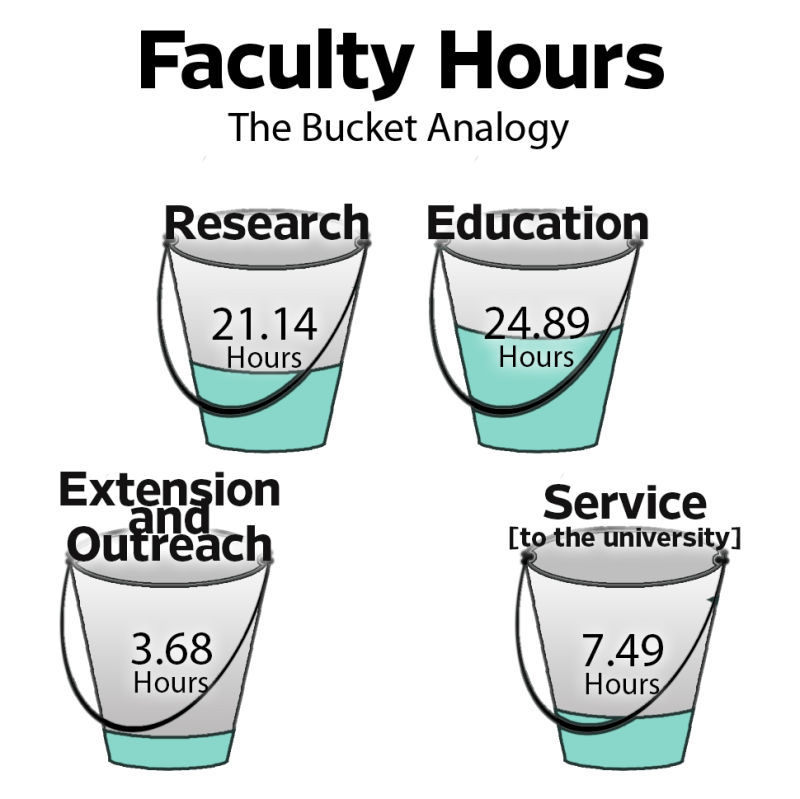Survey shows ISU faculty work more hours than average workers
Graphic: Azwan Azhar/ Iowa State Daily
Faculty at Iowa State University show via hours that they do more than just take attendance and click through PowerPoints.
September 19, 2013
Iowa State faculty do more than simply click through PowerPoint presentations in lectures.
According to the Bureau of Labor Statistics, the average working American worked 44 hours in a five day workweek in 2011. A survey taken of nationwide university full-time faculty members in 2004 showed an average workweek of 55.5 hours.
A comprehensive report presented to the Board of Regents showed ISU faculty worked an average of 57.2 hours, the most in Iowa.
Each faculty member had the opportunity to participate in the survey and document how many hours they dedicated to university-related work.
“At Iowa State, we really enjoy our work; therefore, we’re putting in more hours,” said Faculty Senate President Veronica Dark. “[but] we’re stressed. We are being asked to do more with less.”
Activities contributing to the faculty workload include education, research, extension and outreach and service.
“Think about [the categories] as four buckets,” said Jonathan Wickert, senior vice president and provost. “[The report ] looked at time in the classroom, time preparing for classes, time advising students, supervising students on research projects and different examples of extension and outreach, etc.”
In addition to classroom time, faculty are expected to contribute to their field of study. For example, Dark, professor of psychology, is expected to contribute new insights to the base and understanding of psychology.
“Faculty are hired, in most cases, to both educate students and also do scholarly work,” Dark said. “Iowa State is very proud of the students that we produce. We think we provide a very good education. Everyone is hired because we’re supposed to be contributing to knowledge.”
The added workload from research sometimes results in faculty members working at home and on the weekends. They might work in their office but also in a lab, library or living room.
“A lot of people outside the university and even students don’t appreciate how much effort and time it takes to do the scholarly work. Plus we have to do our educating,” Dark said. “[Educating] is a big part of what we do, but it’s not the only part. That 58 hours a week reflects that it takes a lot of time.”
Approximately 43.5 percent of faculty time was spent on class related activities, according to the survey. However, both Wickert and Dark said percentages dedicated to each category differs across departments and individuals.
“No two faculty are identical,” Wickert said. “Each faculty member’s responsibilities really reflect their own expertise and the way they contribute most to the university.”
Position Responsibility Statements allocate the responsibilities of each individual faculty member in order for that particular member to reach tenure. Dark said most assistant professors don’t do as much committee work as some tenured professors because assistant professors are more focused on educating students and setting up a scholarly research program.
“When you go up to full professor, our tenure document says it will be expected that you have done some important institutional service: contributing to the functioning of the university,” Dark said.
In his annual address, ISU President Steven Leath addressed faculty being stretched too thin, in part, because of increased student enrollment.
“Every time class size goes up, the workload increases,” Dark said. “[Some] used to assign a short homework assignment that you could read through in the weekend, but with twice as many students, [they] can’t do that.”
Although resources and spaces are pushed beyond expectations, the ISU brand is still of top priority, Dark said, with hopes of continuing student-faculty interaction and more than just lecture classes.
As Leath said in his annual address, faculty play a large part in the student experience, and thanked faculty multiple times for their hard work and dedication.
Of the 1,446 surveys sent, 1,226 faculty members responded, both part and full-time members. With a response rate of 84.8 percent, Iowa State had the highest between the three regent universities.
In total, after removing responses that were incomplete or inaccurate, or responses from faculty members who weren’t available for the entire week, a total of 1,111 responses were taken into account.
“When you look across the big picture, I’m very proud of seeing a faculty that’s very high quality that works very hard,” Wickert said. “I couldn’t be more proud with the outcome of the report.”

















